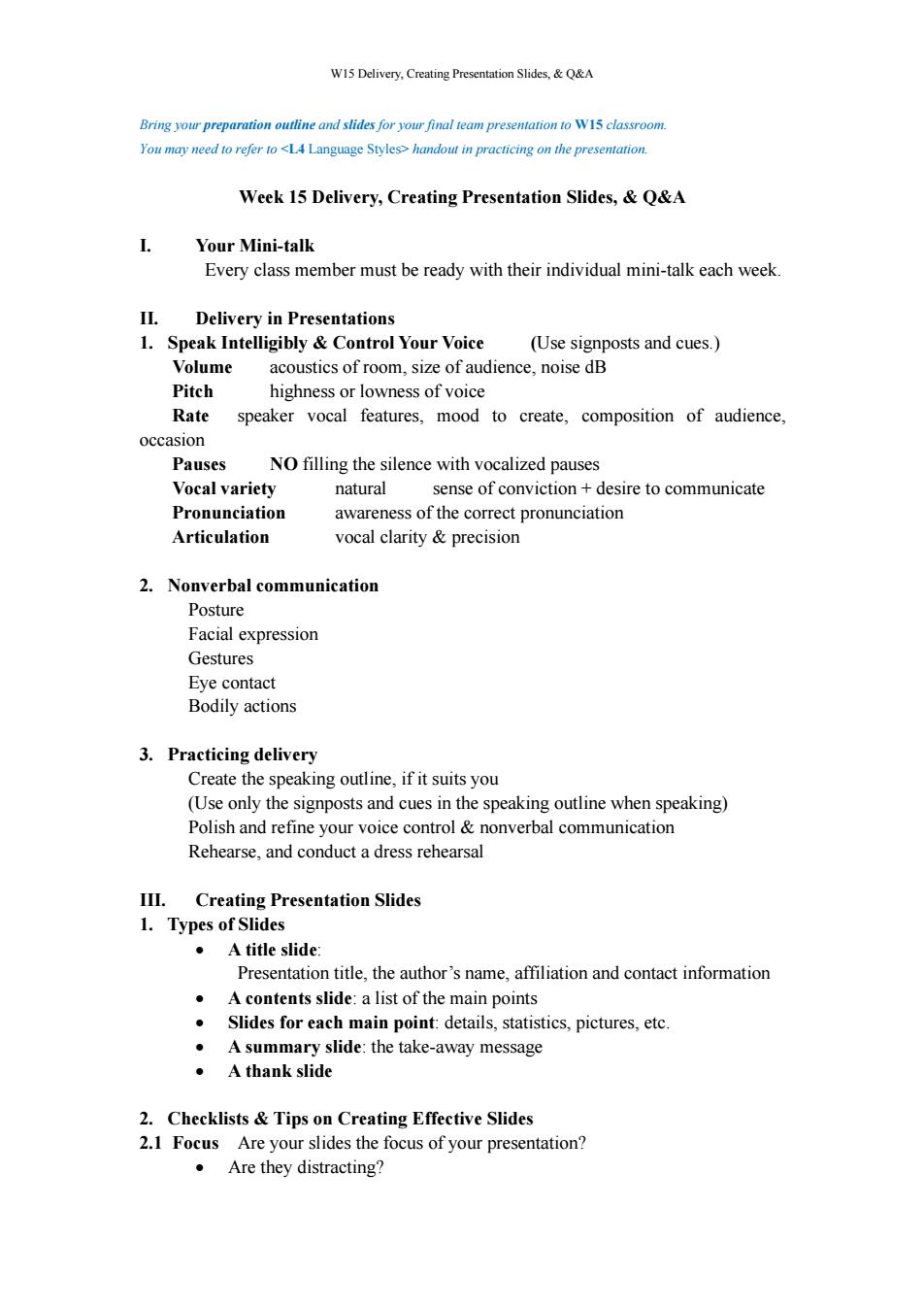
W15 Delivery,Creating Presentation Slides,Q&A Bring your preparation outline and slides for your final team presentation to W15 classroom. You may need to refer to handout in practicing on the presentation. Week 15 Delivery,Creating Presentation Slides,Q&A Your Mini-talk Every class member must be ready with their individual mini-talk each week. II.Delivery in Presentations 1.Speak Intelligibly Control Your Voice (Use signposts and cues.) Volume acoustics of room,size of audience,noise dB Pitch highness or lowness of voice Rate speaker vocal features,mood to create,composition of audience, occasion Pauses NO filling the silence with vocalized pauses Vocal variety natural sense of conviction desire to communicate Pronunciation awareness of the correct pronunciation Articulation vocal clarity precision 2.Nonverbal communication Posture Facial expression Gestures Eye contact Bodily actions 3.Practicing delivery Create the speaking outline,if it suits you (Use only the signposts and cues in the speaking outline when speaking) Polish and refine your voice control nonverbal communication Rehearse,and conduct a dress rehearsal III.Creating Presentation Slides 1.Types of Slides ·A title slide: Presentation title,the author's name,affiliation and contact information A contents slide:a list of the main points Slides for each main point:details,statistics,pictures,etc. A summary slide:the take-away message ·A thank slide 2.Checklists Tips on Creating Effective Slides 2.1 Focus Are your slides the focus of your presentation? ·Are they distracting?
W15 Delivery, Creating Presentation Slides, & Q&A Bring your preparation outline and slides for your final team presentation to W15 classroom. You may need to refer to handout in practicing on the presentation. Week 15 Delivery, Creating Presentation Slides, & Q&A I. Your Mini-talk Every class member must be ready with their individual mini-talk each week. II. Delivery in Presentations 1. Speak Intelligibly & Control Your Voice (Use signposts and cues.) Volume acoustics of room, size of audience, noise dB Pitch highness or lowness of voice Rate speaker vocal features, mood to create, composition of audience, occasion Pauses NO filling the silence with vocalized pauses Vocal variety natural sense of conviction + desire to communicate Pronunciation awareness of the correct pronunciation Articulation vocal clarity & precision 2. Nonverbal communication Posture Facial expression Gestures Eye contact Bodily actions 3. Practicing delivery Create the speaking outline, if it suits you (Use only the signposts and cues in the speaking outline when speaking) Polish and refine your voice control & nonverbal communication Rehearse, and conduct a dress rehearsal III. Creating Presentation Slides 1. Types of Slides A title slide: Presentation title, the author’s name, affiliation and contact information A contents slide: a list of the main points Slides for each main point: details, statistics, pictures, etc. A summary slide: the take-away message A thank slide 2. Checklists & Tips on Creating Effective Slides 2.1 Focus Are your slides the focus of your presentation? Are they distracting?

W15 Delivery,Creating Presentation Slides,&Q&A Are they meaningless? Is it enough to simply read your slides? 2.2 Simplicity Does one slide present only one idea? Are your slides simple in layout and design? phrases instead of sentences ·3-4 bullet points 2.3 Visibility of Text,Graphics,Images: Are they large enough for your audience? Are they projected high enough for your farthest audience? 2.4 Language in slides ·Consistency the same text color,font,size,and capitalization format the first word in each bullet grammatically the same ·Correctness ·run a spell check read your own slides for misspelled words spell consistently in British or American English 3.Expressions to Refer to Slides to Describe Displays in Slides 3.1 Referring to slides: ·As you can see here.. ·Let's have a look at.. I'd like you to look at this... I'd like to draw your attention to... If you look at this slide,you can see... ·This slide shows.. 3.2 Giving explanations .There are two reasons for this.First,...Second,... This can be explained by two factors.Firstly,...Secondly,... ·Due to the fact that.. ·Thanks to.. The problem goes back to... 3.3 Introducing the data This graph/chart/table shows/illustrates that... According to the figures/statistics... 。We can see from.. ·As is shown in the.. On the x/horizontal axis we have .. The vertical/horizontal axis represents/displays... 3.4 Referring to the location ·At the top/.bottom The upper/lower part/half/section Close to/near the top right corner
W15 Delivery, Creating Presentation Slides, & Q&A Are they meaningless? Is it enough to simply read your slides? 2.2 Simplicity Does one slide present only one idea? Are your slides simple in layout and design? • phrases instead of sentences • 3-4 bullet points 2.3 Visibility of Text, Graphics, Images: Are they large enough for your audience? Are they projected high enough for your farthest audience? 2.4 Language in slides Consistency • the same text color, font, size, and capitalization format • the first word in each bullet grammatically the same Correctness • run a spell check • read your own slides for misspelled words • spell consistently in British or American English 3. Expressions to Refer to Slides & to Describe Displays in Slides 3.1 Referring to slides: As you can see here … Let’s have a look at … I’d like you to look at this … I’d like to draw your attention to … If you look at this slide, you can see … This slide shows … 3.2 Giving explanations There are two reasons for this. First, …Second, … This can be explained by two factors. Firstly, …Secondly, … Due to the fact that … Thanks to … The problem goes back to … 3.3 Introducing the data This graph/chart/table shows/illustrates that … According to the figures/statistics … We can see from … As is shown in the … On the x/horizontal axis we have … The vertical/horizontal axis represents/displays … 3.4 Referring to the location At the top/bottom The upper/lower part/half/section Close to/near the top right corner
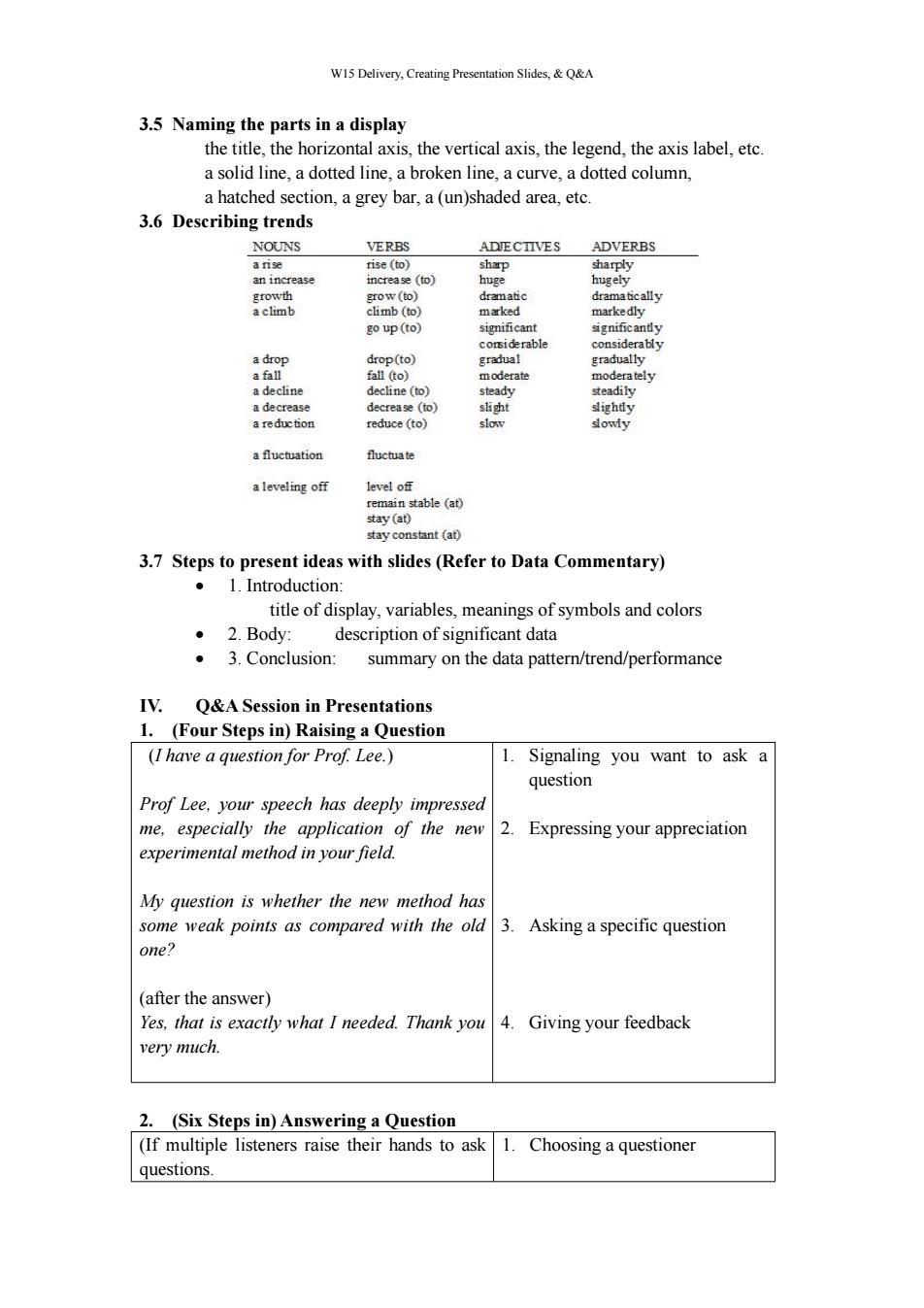
W15 Delivery,Creating Presentation Slides,&Q&A 3.5 Naming the parts in a display the title,the horizontal axis,the vertical axis,the legend,the axis label,etc. a solid line,a dotted line,a broken line,a curve,a dotted column, a hatched section,a grey bar,a (un)shaded area,etc. 3.6 Describing trends NOUNS VERBS ADECTIVES ADVERBS a rise rise (to) sharp sharply an increase increase (to) huge hugely growth grow (to) dramatic dramatically a climb climb (to) marked markedly go up(to) significant significandy comsiderable considerably a drop drop(to) gradual gradually a fall fall (to) moderate moderately a decline decline(to) steady steadily a decrease decrease (to) si中t slighty a reduction reduce (to) slow sowiy a fluctuation fluctuate a leveling off level off remain stable (at) stay(at) stay constant (at) 3.7 Steps to present ideas with slides(Refer to Data Commentary) ·l.Introduction: title of display,variables,meanings of symbols and colors ·2.Body: description of significant data ·3.Conclusion: summary on the data pattern/trend/performance IV. Q&A Session in Presentations 1.(Four Steps in)Raising a Question (I have a question for Prof.Lee.) 1.Signaling you want to ask a question Prof Lee,your speech has deeply impressed me,especially the application of the new 2.Expressing your appreciation experimental method in your field. My question is whether the new method has some weak points as compared with the old 3.Asking a specific question one? (after the answer) Yes,that is exactly what I needed.Thank you 4.Giving your feedback very much. 2.(Six Steps in)Answering a Question (If multiple listeners raise their hands to ask 1. Choosing a questioner questions
W15 Delivery, Creating Presentation Slides, & Q&A 3.5 Naming the parts in a display the title, the horizontal axis, the vertical axis, the legend, the axis label, etc. a solid line, a dotted line, a broken line, a curve, a dotted column, a hatched section, a grey bar, a (un)shaded area, etc. 3.6 Describing trends 3.7 Steps to present ideas with slides (Refer to Data Commentary) 1. Introduction: title of display, variables, meanings of symbols and colors 2. Body: description of significant data 3. Conclusion: summary on the data pattern/trend/performance IV. Q&A Session in Presentations 1. (Four Steps in) Raising a Question (I have a question for Prof. Lee.) Prof Lee, your speech has deeply impressed me, especially the application of the new experimental method in your field. My question is whether the new method has some weak points as compared with the old one? (after the answer) Yes, that is exactly what I needed. Thank you very much. 1. Signaling you want to ask a question 2. Expressing your appreciation 3. Asking a specific question 4. Giving your feedback 2. (Six Steps in) Answering a Question (If multiple listeners raise their hands to ask questions. 1. Choosing a questioner
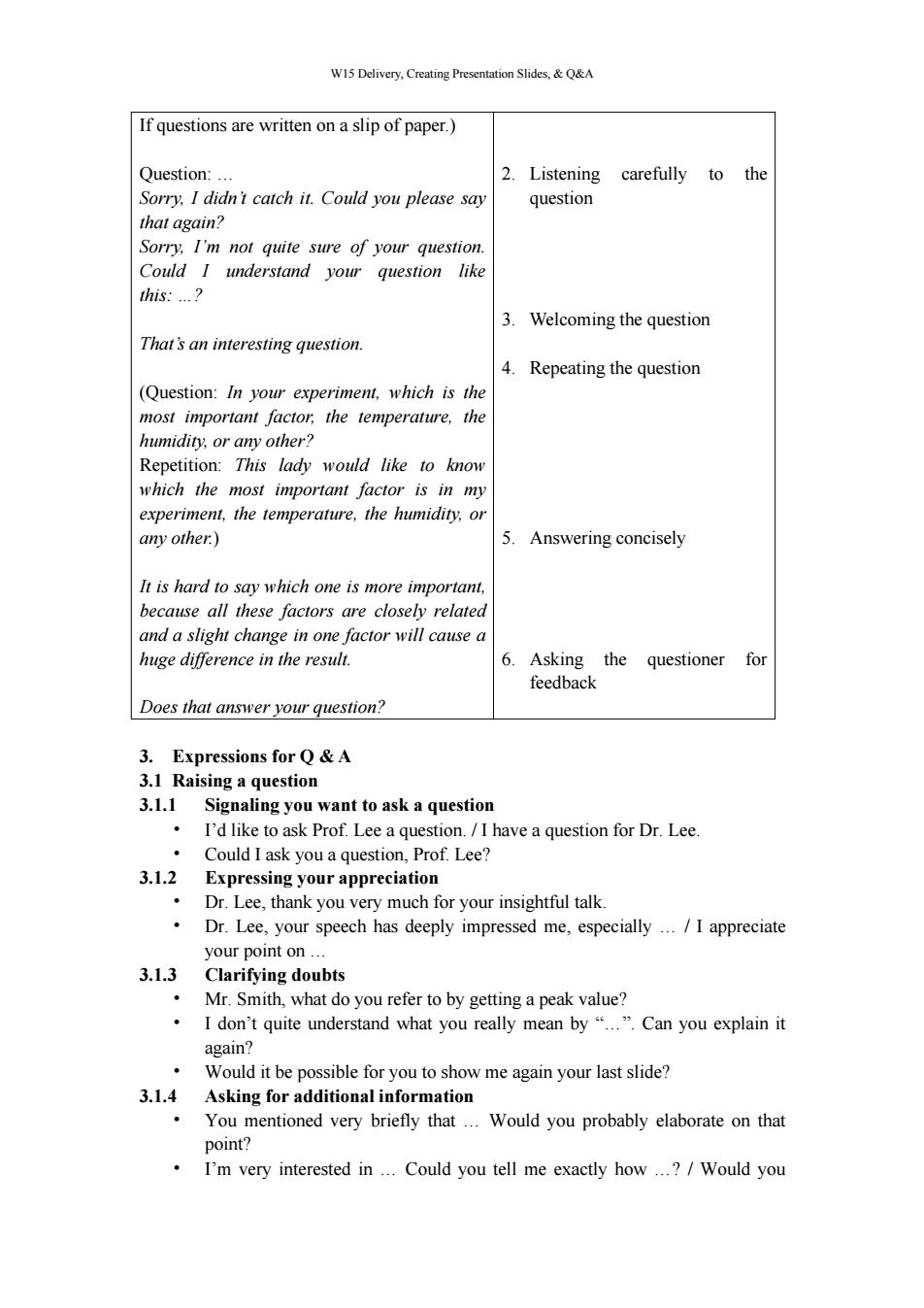
W15 Delivery,Creating Presentation Slides,&Q&A If questions are written on a slip of paper.) Question:.. 2.Listening carefully to the Sorry,I didn't catch it.Could you please say question that again? Sorry,I'm not quite sure of your question. Could I understand your question like this:? 3. Welcoming the question That's an interesting question. 4.Repeating the question (Question:In your experiment,which is the most important factor;the temperature,the humidity,or any other? Repetition:This lady would like to know which the most important factor is in my experiment,the temperature,the humidity,or any other.) 5.Answering concisely It is hard to say which one is more important, because all these factors are closely related and a slight change in one factor will cause a huge difference in the result. 6. Asking the questioner for feedback Does that answer your question? 3.Expressions for Q &A 3.1 Raising a question 3.1.1 Signaling you want to ask a question I'd like to ask Prof.Lee a question./I have a question for Dr.Lee. Could I ask you a question,Prof.Lee? 3.1.2 Expressing your appreciation Dr.Lee,thank you very much for your insightful talk. Dr.Lee,your speech has deeply impressed me,especially.../I appreciate your point on... 3.1.3 Clarifying doubts Mr.Smith,what do you refer to by getting a peak value? I don't quite understand what you really mean by "..."Can you explain it again? Would it be possible for you to show me again your last slide? 3.1.4 Asking for additional information You mentioned very briefly that...Would you probably elaborate on that point? I'm very interested in...Could you tell me exactly how...?/Would you
W15 Delivery, Creating Presentation Slides, & Q&A If questions are written on a slip of paper.) Question: … Sorry, I didn’t catch it. Could you please say that again? Sorry, I’m not quite sure of your question. Could I understand your question like this: …? That’s an interesting question. (Question: In your experiment, which is the most important factor, the temperature, the humidity, or any other? Repetition: This lady would like to know which the most important factor is in my experiment, the temperature, the humidity, or any other.) It is hard to say which one is more important, because all these factors are closely related and a slight change in one factor will cause a huge dif erence in the result. Does that answer your question? 2. Listening carefully to the question 3. Welcoming the question 4. Repeating the question 5. Answering concisely 6. Asking the questioner for feedback 3. Expressions for Q & A 3.1 Raising a question 3.1.1 Signaling you want to ask a question • I’d like to ask Prof. Lee a question. / I have a question for Dr. Lee. • Could I ask you a question, Prof. Lee? 3.1.2 Expressing your appreciation • Dr. Lee, thank you very much for your insightful talk. • Dr. Lee, your speech has deeply impressed me, especially … / I appreciate your point on … 3.1.3 Clarifying doubts • Mr. Smith, what do you refer to by getting a peak value? • I don’t quite understand what you really mean by “…”. Can you explain it again? • Would it be possible for you to show me again your last slide? 3.1.4 Asking for additional information • You mentioned very briefly that … Would you probably elaborate on that point? • I’m very interested in … Could you tell me exactly how …? / Would you
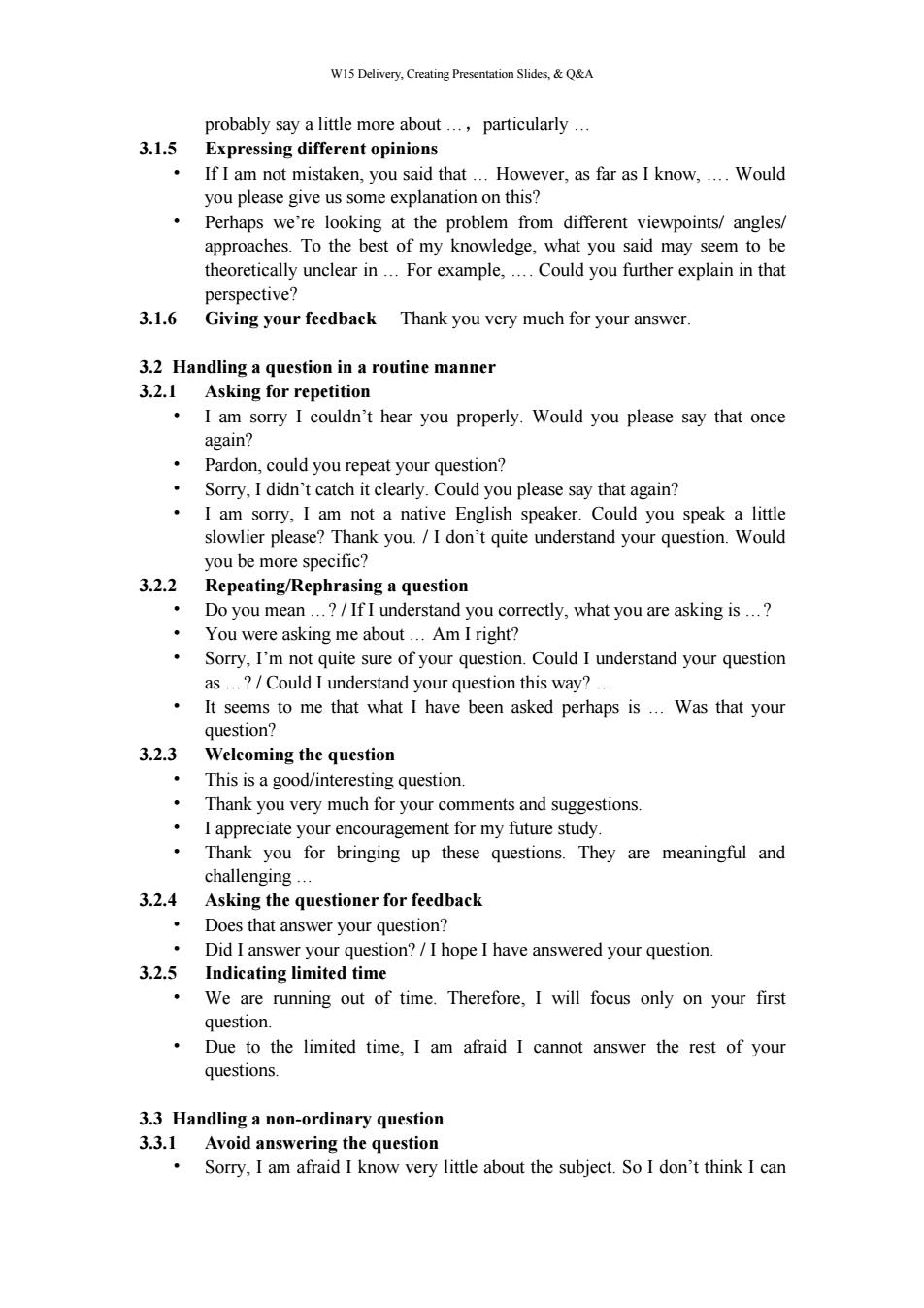
W15 Delivery,Creating Presentation Slides,&Q&A probably say a little more about...,particularly... 3.1.5 Expressing different opinions If I am not mistaken,you said that...However,as far as I know,....Would you please give us some explanation on this? Perhaps we're looking at the problem from different viewpoints/angles/ approaches.To the best of my knowledge,what you said may seem to be theoretically unclear in...For example,....Could you further explain in that perspective? 3.1.6 Giving your feedback Thank you very much for your answer. 3.2 Handling a question in a routine manner 3.2.1 Asking for repetition I am sorry I couldn't hear you properly.Would you please say that once again? Pardon,could you repeat your question? Sorry,I didn't catch it clearly.Could you please say that again? I am sorry,I am not a native English speaker.Could you speak a little slowlier please?Thank you./I don't quite understand your question.Would you be more specific? 3.2.2 Repeating/Rephrasing a question Do you mean...?/If I understand you correctly,what you are asking is...? You were asking me about...Am I right? 。 Sorry,I'm not quite sure of your question.Could I understand your question as...?/Could I understand your question this way?... It seems to me that what I have been asked perhaps is...Was that your question? 3.2.3 Welcoming the question This is a good/interesting question. Thank you very much for your comments and suggestions. I appreciate your encouragement for my future study. Thank you for bringing up these questions.They are meaningful and challenging... 3.2.4 Asking the questioner for feedback Does that answer your question? Did I answer your question?/I hope I have answered your question. 3.2.5 Indicating limited time We are running out of time.Therefore,I will focus only on your first question. Due to the limited time,I am afraid I cannot answer the rest of your questions. 3.3 Handling a non-ordinary question 3.3.1 Avoid answering the question Sorry,I am afraid I know very little about the subject.So I don't think I can
W15 Delivery, Creating Presentation Slides, & Q&A probably say a little more about …,particularly … 3.1.5 Expressing different opinions • If I am not mistaken, you said that … However, as far as I know, …. Would you please give us some explanation on this? • Perhaps we’re looking at the problem from different viewpoints/ angles/ approaches. To the best of my knowledge, what you said may seem to be theoretically unclear in … For example, …. Could you further explain in that perspective? 3.1.6 Giving your feedback Thank you very much for your answer. 3.2 Handling a question in a routine manner 3.2.1 Asking for repetition • I am sorry I couldn’t hear you properly. Would you please say that once again? • Pardon, could you repeat your question? • Sorry, I didn’t catch it clearly. Could you please say that again? • I am sorry, I am not a native English speaker. Could you speak a little slowlier please? Thank you. / I don’t quite understand your question. Would you be more specific? 3.2.2 Repeating/Rephrasing a question • Do you mean …? / If I understand you correctly, what you are asking is …? • You were asking me about … Am I right? • Sorry, I’m not quite sure of your question. Could I understand your question as …? / Could I understand your question this way? … • It seems to me that what I have been asked perhaps is … Was that your question? 3.2.3 Welcoming the question • This is a good/interesting question. • Thank you very much for your comments and suggestions. • I appreciate your encouragement for my future study. • Thank you for bringing up these questions. They are meaningful and challenging … 3.2.4 Asking the questioner for feedback • Does that answer your question? • Did I answer your question? / I hope I have answered your question. 3.2.5 Indicating limited time • We are running out of time. Therefore, I will focus only on your first question. • Due to the limited time, I am afraid I cannot answer the rest of your questions. 3.3 Handling a non-ordinary question 3.3.1 Avoid answering the question • Sorry, I am afraid I know very little about the subject. So I don’t think I can
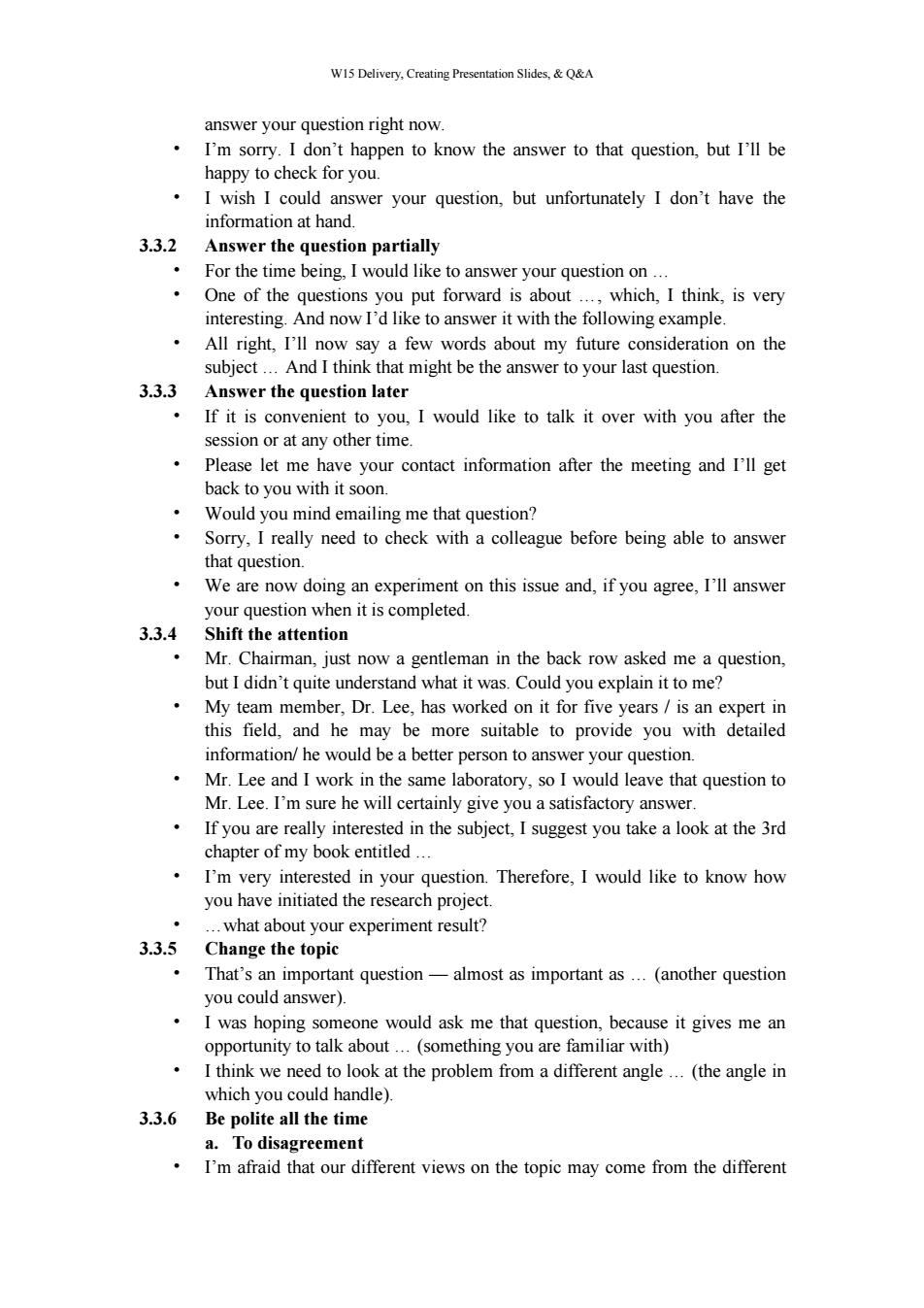
W15 Delivery,Creating Presentation Slides,&Q&A answer your question right now. I'm sorry.I don't happen to know the answer to that question,but I'll be happy to check for you. I wish I could answer your question,but unfortunately I don't have the information at hand. 3.3.2 Answer the question partially For the time being,I would like to answer your question on... One of the questions you put forward is about...,which,I think,is very interesting.And now I'd like to answer it with the following example. All right,I'll now say a few words about my future consideration on the subject...And I think that might be the answer to your last question. 3.3.3 Answer the question later If it is convenient to you,I would like to talk it over with you after the session or at any other time. Please let me have your contact information after the meeting and I'll get back to you with it soon. Would you mind emailing me that question? Sorry,I really need to check with a colleague before being able to answer that question. We are now doing an experiment on this issue and,if you agree,I'll answer your question when it is completed. 3.3.4 Shift the attention Mr.Chairman,just now a gentleman in the back row asked me a question, but I didn't quite understand what it was.Could you explain it to me? My team member,Dr.Lee,has worked on it for five years /is an expert in this field,and he may be more suitable to provide you with detailed information/he would be a better person to answer your question. Mr.Lee and I work in the same laboratory,so I would leave that question to Mr.Lee.I'm sure he will certainly give you a satisfactory answer. If you are really interested in the subject,I suggest you take a look at the 3rd chapter of my book entitled... I'm very interested in your question.Therefore,I would like to know how you have initiated the research project. ...what about your experiment result? 3.3.5 Change the topic That's an important question-almost as important as...(another question you could answer). I was hoping someone would ask me that question,because it gives me an opportunity to talk about...(something you are familiar with) I think we need to look at the problem from a different angle...(the angle in which you could handle). 3.3.6 Be polite all the time a.To disagreement I'm afraid that our different views on the topic may come from the different
W15 Delivery, Creating Presentation Slides, & Q&A answer your question right now. • I’m sorry. I don’t happen to know the answer to that question, but I’ll be happy to check for you. • I wish I could answer your question, but unfortunately I don’t have the information at hand. 3.3.2 Answer the question partially • For the time being, I would like to answer your question on … • One of the questions you put forward is about …, which, I think, is very interesting. And now I’d like to answer it with the following example. • All right, I’ll now say a few words about my future consideration on the subject … And I think that might be the answer to your last question. 3.3.3 Answer the question later • If it is convenient to you, I would like to talk it over with you after the session or at any other time. • Please let me have your contact information after the meeting and I’ll get back to you with it soon. • Would you mind emailing me that question? • Sorry, I really need to check with a colleague before being able to answer that question. • We are now doing an experiment on this issue and, if you agree, I’ll answer your question when it is completed. 3.3.4 Shift the attention • Mr. Chairman, just now a gentleman in the back row asked me a question, but I didn’t quite understand what it was. Could you explain it to me? • My team member, Dr. Lee, has worked on it for five years / is an expert in this field, and he may be more suitable to provide you with detailed information/ he would be a better person to answer your question. • Mr. Lee and I work in the same laboratory, so I would leave that question to Mr. Lee. I’m sure he will certainly give you a satisfactory answer. • If you are really interested in the subject, I suggest you take a look at the 3rd chapter of my book entitled … • I’m very interested in your question. Therefore, I would like to know how you have initiated the research project. • …what about your experiment result? 3.3.5 Change the topic • That’s an important question — almost as important as … (another question you could answer). • I was hoping someone would ask me that question, because it gives me an opportunity to talk about … (something you are familiar with) • I think we need to look at the problem from a different angle … (the angle in which you could handle). 3.3.6 Be polite all the time a. To disagreement • I’m afraid that our different views on the topic may come from the different
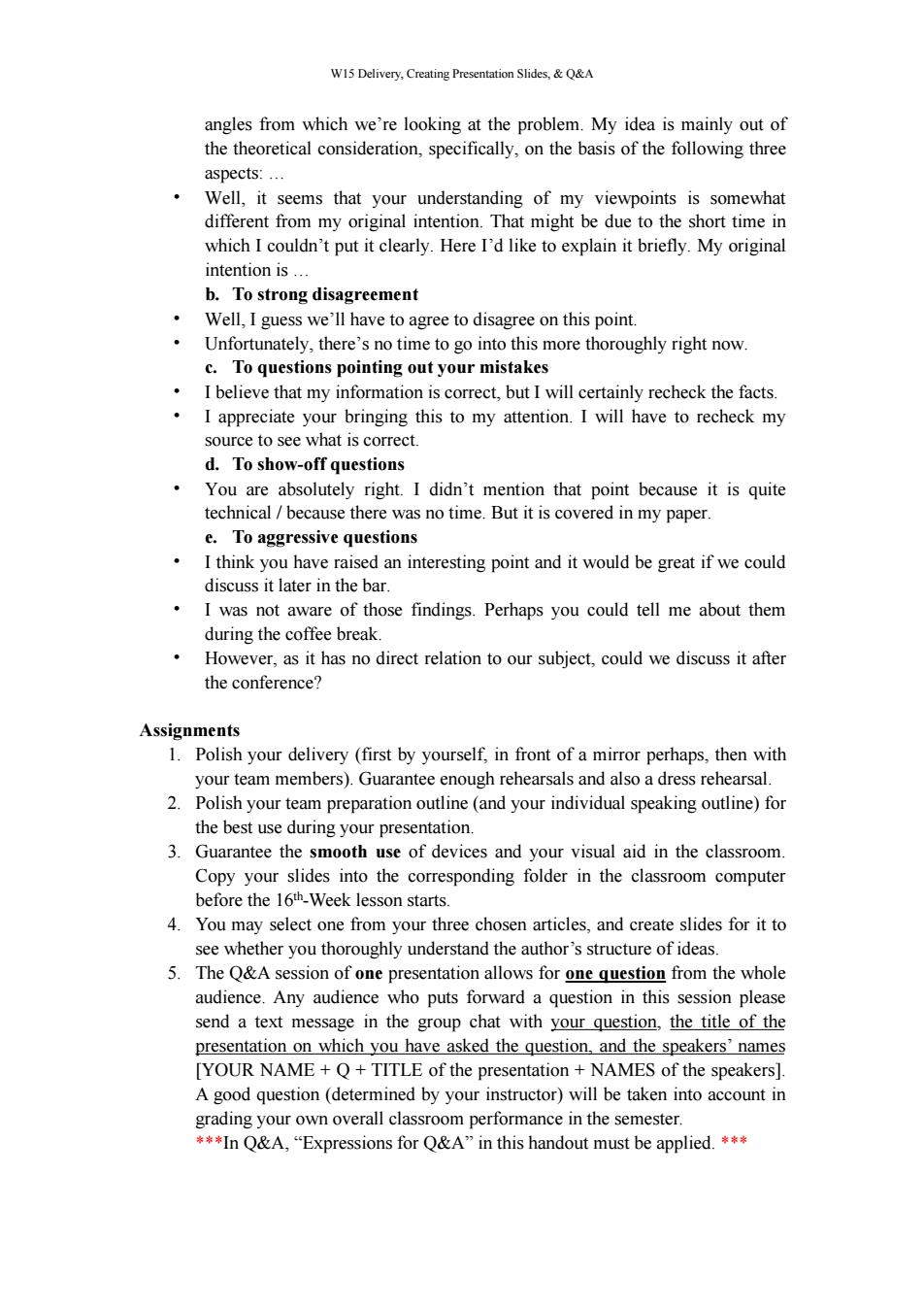
W15 Delivery,Creating Presentation Slides,&Q&A angles from which we're looking at the problem.My idea is mainly out of the theoretical consideration,specifically,on the basis of the following three aspects:... Well,it seems that your understanding of my viewpoints is somewhat different from my original intention.That might be due to the short time in which I couldn't put it clearly.Here I'd like to explain it briefly.My original intention is... b.To strong disagreement Well,I guess we'll have to agree to disagree on this point Unfortunately,there's no time to go into this more thoroughly right now. c.To questions pointing out your mistakes I believe that my information is correct,but I will certainly recheck the facts. I appreciate your bringing this to my attention.I will have to recheck my source to see what is correct. d.To show-off questions You are absolutely right.I didn't mention that point because it is quite technical because there was no time.But it is covered in my paper. e.To aggressive questions I think you have raised an interesting point and it would be great if we could discuss it later in the bar. I was not aware of those findings.Perhaps you could tell me about them during the coffee break. However,as it has no direct relation to our subject,could we discuss it after the conference? Assignments 1.Polish your delivery(first by yourself,in front of a mirror perhaps,then with your team members).Guarantee enough rehearsals and also a dress rehearsal. 2.Polish your team preparation outline(and your individual speaking outline)for the best use during your presentation. 3.Guarantee the smooth use of devices and your visual aid in the classroom. Copy your slides into the corresponding folder in the classroom computer before the 16th-Week lesson starts. 4.You may select one from your three chosen articles,and create slides for it to see whether you thoroughly understand the author's structure of ideas. 5.The Q&A session of one presentation allows for one question from the whole audience.Any audience who puts forward a question in this session please send a text message in the group chat with your question,the title of the presentation on which you have asked the question,and the speakers'names [YOUR NAME +Q+TITLE of the presentation NAMES of the speakers]. A good question (determined by your instructor)will be taken into account in grading your own overall classroom performance in the semester. ***In Q&A,"Expressions for Q&A"in this handout must be applied.**
W15 Delivery, Creating Presentation Slides, & Q&A angles from which we’re looking at the problem. My idea is mainly out of the theoretical consideration, specifically, on the basis of the following three aspects: … • Well, it seems that your understanding of my viewpoints is somewhat different from my original intention. That might be due to the short time in which I couldn’t put it clearly. Here I’d like to explain it briefly. My original intention is … b. To strong disagreement • Well, I guess we’ll have to agree to disagree on this point. • Unfortunately, there’s no time to go into this more thoroughly right now. c. To questions pointing out your mistakes • I believe that my information is correct, but I will certainly recheck the facts. • I appreciate your bringing this to my attention. I will have to recheck my source to see what is correct. d. To show-off questions • You are absolutely right. I didn’t mention that point because it is quite technical / because there was no time. But it is covered in my paper. e. To aggressive questions • I think you have raised an interesting point and it would be great if we could discuss it later in the bar. • I was not aware of those findings. Perhaps you could tell me about them during the coffee break. • However, as it has no direct relation to our subject, could we discuss it after the conference? Assignments 1. Polish your delivery (first by yourself, in front of a mirror perhaps, then with your team members). Guarantee enough rehearsals and also a dress rehearsal. 2. Polish your team preparation outline (and your individual speaking outline) for the best use during your presentation. 3. Guarantee the smooth use of devices and your visual aid in the classroom. Copy your slides into the corresponding folder in the classroom computer before the 16 th-Week lesson starts. 4. You may select one from your three chosen articles, and create slides for it to see whether you thoroughly understand the author’s structure of ideas. 5. The Q&A session of one presentation allows for one question from the whole audience. Any audience who puts forward a question in this session please send a text message in the group chat with your question, the title of the presentation on which you have asked the question, and the speakers’ names [YOUR NAME + Q + TITLE of the presentation + NAMES of the speakers]. A good question (determined by your instructor) will be taken into account in grading your own overall classroom performance in the semester. ***In Q&A, “Expressions for Q&A” in this handout must be applied. ***